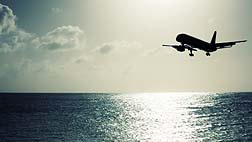 While it is too early to tell if the debris is indeed wreckage from the presumably doomed plane, searchers have sighted floating debris that includes an airplane seat floating in the Atlantic Ocean about 400 miles from the island of Fernando de Noronha.
While it is too early to tell if the debris is indeed wreckage from the presumably doomed plane, searchers have sighted floating debris that includes an airplane seat floating in the Atlantic Ocean about 400 miles from the island of Fernando de Noronha.Air France flight AF 447 disappeared early yesterday about three hours into a trans-Atlantic flight from Brazil to Paris. Aviation officials report the plane encountered heavy turbulence in the wee hours of Monday morning. Soon after, according to a report from CNN, the Airbus' automatic systems initiated a four-minute series of messages to the company's maintenance computers.
The messages indicated that "several pieces of aircraft equipment were at fault or had broken down," according to a statement by Air France CEO Pierre-Henri Gourgeon. There was no contact with the crew during that period, he told the press. "It was probable that it was a little bit after those messages that the impact of the plane took place in the Atlantic," he added.
Among the 228 occupants on board the plane were two Americans. Michael Harris, 60, and his wife Anne, 54 were identified by the couple's family and his employer.
"Anne and Mike were indeed a beautiful couple inside and out, and I miss them terribly already," said Anne Harris' sister, Mary Miley.
CNN reports that Michael Harris was a geologist in Rio de Janeiro for Devon Energy, the largest U.S.-based independent natural gas and oil producer, according to a company spokesman.The couple had lived in the city since July 2008 and was traveling to Paris for a training seminar for Michael and for a vacation, Miley told CNN.
Much speculation has occurred duirng the last 24 hours as to what might have felled the Airbus A330, a modern plane that is considered a stalwart of trans-Atlantic flight. The aircraft was relatively new—April 2005—and had undergone it's most recent hangar inspection in April. The crew was experienced.
And if there was a lightning strike, as many have speculated, modern planes are built to withstand such an event. The outer aluminum skin of the plane is insulated from the inner shroud made of largley non-conductive materials. Vital equipment is shielded. In the event of a lightning strike, the electrical energy is directed out, along and ultimately away from the plane's outer skin.
In sum, the Airbus A330 is built to withstand pretty much anything Mother Nature can throw its way.
However, it should be noted that the Airbus A330 is also an extremely sophisticated aircraft that flies by-wire. That means that there are no mechanical, or hydraulic links between the controls in the cockpit and the plane's fundamental aerodynamic systems. Electronic mpulses are sent from the cockpit to components such as wing flaps by small wires.
The entire operation is controlled by a series of computers that literally take the airplane's control out of the pilot's hands in certain situations. One analyst quoted in the New York Times today likened the possibility of whatever happened to AF 447, to a series of events that befell two Quantas jets last year. According to reports, sensors in the plane sent the wrong signals to the aircraft computers, which caused the plane to lose altitude in rapid sequence.
The expert suggested, for example, that were sensors to determine incorrectly that the aircraft was about to go into a stall, information would be directed to on-board computers that would nose the plane down automatically and increase speed in order to generate lift.
However, says Hans Weber who heads the Tecop aviation consulting firm in San Diego,
if the plane were to suddenly dive in tandem with a severe downdraft in storm turbulance,
such an event would be difficult to recover from.
READ MORE Air Disaster LEGAL NEWS
With Air France Flight AF 447, there was also an indication of sudden loss of cabin pressure.
It is unknown if the black box will be recovered. The area where the plane is presumed to have impacted the water is about 2 miles deep.
According to a report in the New York Times posted a few minutes ago, search officials spotted an airplane seat, a life jacket, some white pieces of material and signs of fuel. An official told the Associated Press that there was no sign of life admist the debris, and there is little hope of finding any of the 228 occupants of the Air France plane crash alive.
